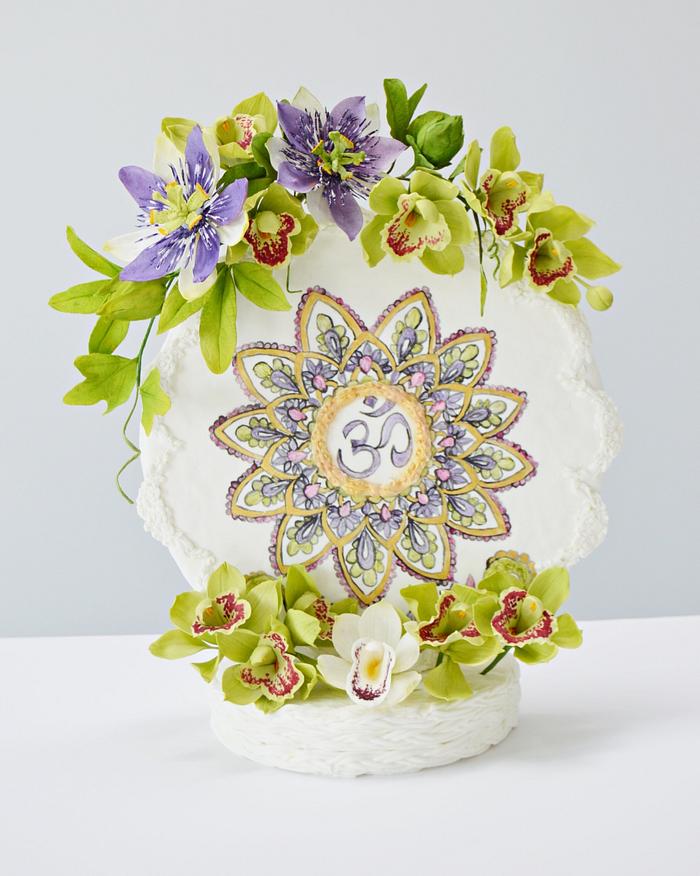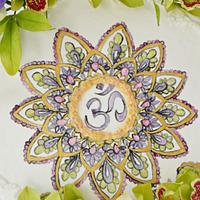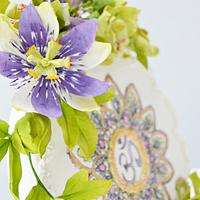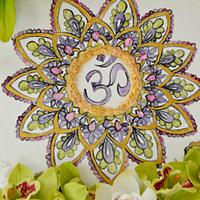Omm- International Yoga Day Collaboration
Omm- International Yoga Day Collaboration




 expand all pictures
expand all pictures
My piece for World Yoga day: Ommm.
Mi pieza para la colaboración del Día Mundial del Yoga
Descripción en español más abajo.
It’s often the first and last sound in your ears in a yoga class. But what does it mean? Perhaps you’ve heard it defined as “the sound of the universe” — but what does that really mean?
Turns out, a lot — and yet, like many spiritual (and especially yogic) things, it’s not so easy to define. “It’s big. Om is nebulous, and it’s vague. It can mean almost anything,” says Yoganand Michael Carroll, dean of the Kripalu School of Yoga.
For starters, it’s all about sacred threes. Most faiths have trinities in their roots and Hinduism, where om was born, is no different. Even though it’s usually pronounced seamlessly so it rhymes with “home,” om is made up of three syllables: A, U, and M, or, phonetically, “aaah,” “oooh,” and “mmm.” Experts say these syllables can represent a slew of trios, including: the heavens, earth, and the underworld; the Hindu gods Brahma, Vishnu, and Shiva (aka creator god, sustainer god, and destroyer god); and the waking, dreaming, and dreamless states — “to represent all of consciousness,” says Yoganand.
The sound appears to have first cropped up in the Upanishads, a collection of sacred texts that inform Hinduism. The Mandukya Upanishad, which is entirely devoted to om, begins like this: “Om is the imperishable word. Om is the universe, and this is the exposition of om. The past, the present, and the future, all that was, all that is, all that will be is om. Likewise, all else that may exist beyond the bounds of time, that too is om.” That pretty much covers it; om is big indeed.
Om is also considered the mother of the bija, or “seed” mantras — short, potent sounds that correlate to each chakra and fuel longer chants (like, say, Om Namah Shivaya). Depending on who you talk to, it relates to either the third eye or the crown chakra, connecting us to the Divine. No wonder its core to some Buddhist systems and other Indian religions. Some say it’s even among the sounds recorded in deep space — on NASA’s website, Earth itself sounds a bit om-y.
Some scholars say that the shape of the visual om symbol embodies each of its syllables — the three is the Sanskrit letter for “ahh,” that same three with the mini S on it is “oooh,” and the bindhi and half-moon at the top are the “mmm.” Some say the symbol is connected to Ganesh, the Hindu half-elephant god who removes obstacles, because if you squint, you can see his rotund curves and graceful trunk represented.
Many layers of meaning are there for the delving, yet om has endured in popularity simply because of its vibration — how we feel when we chant it. “The sound itself seems to calm the nervous system,” says Stephen Cope, founder of Kripalu’s Institute for Extraordinary Living, and author, most recently, of The Great Work of Your Life: A Guide for the Journey to Your True Calling. “Like all chants, it gathers and focuses the mind, and in that state it’s not vulnerable to the rising of the odd thought that will create grasping or aversion. It shifts us out of our ordinary discursive mind and into a more contemplative mode.”
It also unites us as a group. “When we sound om together, we’re aligning body/mind/spirit; we’re aligning with one another; we’re aligning with the universe because it’s the sound of the universe and we’re referencing something real,” says Bhavani Lorraine Nelson, who leads workshops around the world on the power of the voice and is the creator of the CD series Meditation Made Possible. “It’s a very grounding and peaceful sound. One teacher said that if you simply go through life chanting om, the very air around you will sparkle.”
That sense of infinity you feel as that final “mmm” gradually fades into nothing is enhanced by what many call the fourth syllable of om (sorry, trinity-lovers!): silence. “So often in my classes we will sound om, letting those three-voiced parts go very consciously through the cathedral of the mouth, and then sit for a moment in that silence after and simply observe what that feels like,” Bhavani says.
Yoganand says that chanting om also creates a link with those who have practiced before us. “It’s a sound that validates oneness and harmony,” he says. “We chant it because yogis have for thousands of years. And when we chant it, we’re connecting with those yogis in a ritual way, and drawing upon the support of the practices they’ve been doing for a long, long time.”
Ommm. OmmOM es una sílaba poderosa y fundamental que proviene del hinduismo y que se ha popularizado hoy en día en todo Occidente como el símbolo de la mente en calma a la que se llega a través de la Meditación.
OM
En realidad, su función y significado van mucho más allá. OM es el Sonido Primordial del Universo, en el hinduismo significa unidad con lo supremo, la combinación de lo físico con lo espiritual. Es la sílaba sagrada, el primer sonido del Todopoderoso, el sonido del que emergen todos los demás sonidos, ya sea música o lenguaje: “Patanjali, el mejor y más grande exponente del yoga, habla de Dios como el real Sonido Cósmico de OM que se escucha en la Meditación. OM es el Verbo Creador, el sonido del Motor Vibratorio, el testigo de la Divina Presencia.”(Autobiografía de un Yogui, Paramahansa Yogananda). En la Biblia también encontramos referencia a esa Vibración Original:“En el principio existía la Palabra y la Palabra estaba junto a Dios, y la Palabra era Dios.(…) Todo se hizo por ella (la Palabra u OM) y sin ella no se hizo nada” (San Juan 1:1-3). La vibración está en el origen de todo lo que Es y el origen de todo lo que Es está representado por este sonido OM.
big-bang
De OM se podría decir que es lo que los científicos han denominado la teoría del Big Bang muchos siglos después de que los Vedas ya nos hablaran de ello en sus escritos. El sonido es la primera manifestación de todo y OM es el primer sonido a partir del cual se desarrolló toda la creación. La existencia deviene de la vibración, que en su mayor o menor densificación forma las cosas. OM es sonido y el sonido OM ordena la energía, es la fuente, el sostén y la fuerza. Es el aliento vital en cada ser.
En los Upanishad (libros sagrados hinduistas) se dice que todo, lo que existe y lo que no, puede ser controlado al pronunciar la sílaba sagrada. OM es también la forma sonora del atman (alma o dios) y la representación del Trimurti (‘tres formas’) de Brahma, Vishnu y Shiva.
hinduismo2
En Sánscrito, el significado de Om es avati o rakṣati. Rakṣati significa “quien protege o sostiene”. El símbolo que representa a la sílaba OM, tan conocido y utilizado, es el símbolo del conocimiento espiritual y en su composición contiene distintos estados del ser:
– la curva superior es el estado despertar, estado consciente, donde trabajan el intelecto y los sentidos.
– La curva inferior larga representa el estado de sueño, cuando estamos dormidos. La mente, la percepción sensorial y el yo están desactivados y permiten descansar y entrar en contacto con lo sublime.
– La curva semejante a una “s” que parte del centro, simboliza el dormir profundo y sin sueños. Impresiones, deseos y recuerdos están presentes en este estado.
– La media luna, denominada Turiya, es la representación de Maya, el velo de la ilusión, es el cuarto estado, en el que se trasciende el mundo sensorial.
– El punto sobre la media luna, Bindu, es el estado trascendental. Representa el origen y final de Todo. En este estado es cuando el espíritu individual del hombre atraviesa el velo, descansa en lo trascendental y se libera.
El Apocalipsis 3:14 dice: “ Así habla el Amén, el Testigo fiel y veraz, el Principio de la Creación de Dios” . El OM de los Vedas se transformó en la palabra sagrada Amín de los musulmanes, el Hum de los Tibetanos y el Amén de los egipcios, griegos, romanos, judíos y cristianos (en hebreo Amén significa fiel, seguro).
Catalina Anghel
44 Comments
Beautiful!!
Fantástico!!! Me encanta!💞
Rosa Guerra
Amazing!!!
N SUGAR ART
love those flowers
Delicate cake by Yomna Elazawy
Lovely!
Anka
So beautiful
The Cookie Lab by Marta Torres
Fantastic💖
sugar voyager
Como siempre fantastica pieza
SecretosVerdeVioleta by Silvia De Diego
Truly gorgeous! Love your amazing flowers! ❤️👏🏻👏🏻
Beautiful Xx
T Xx










